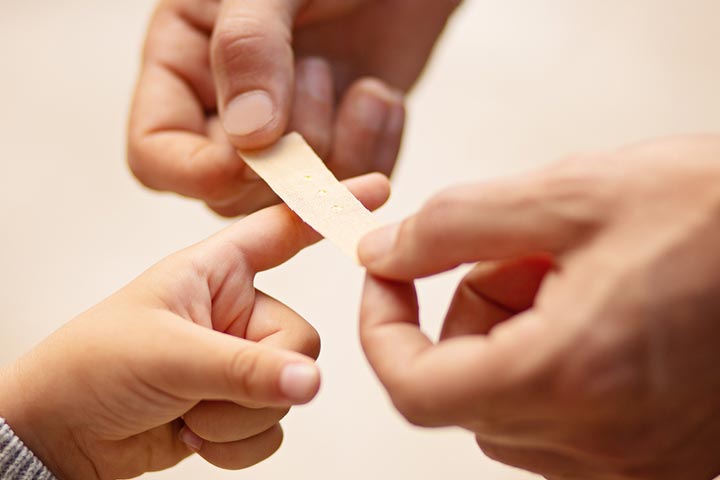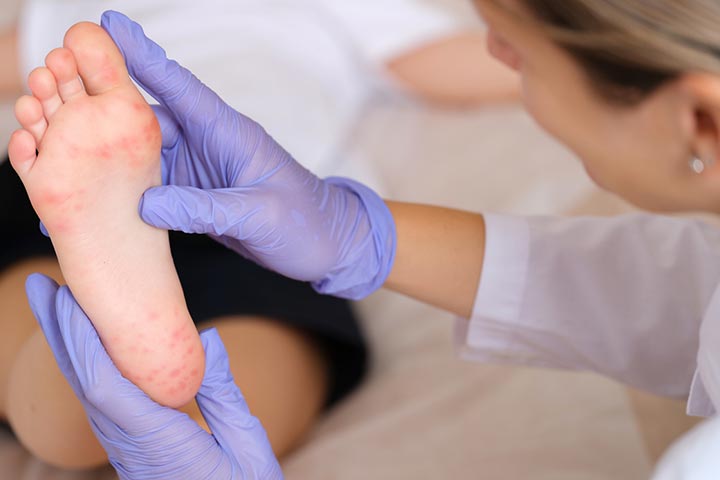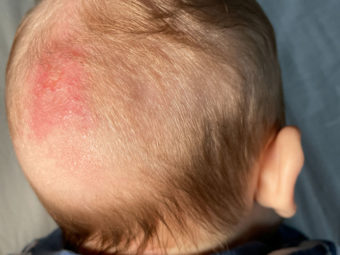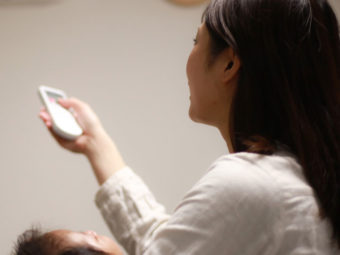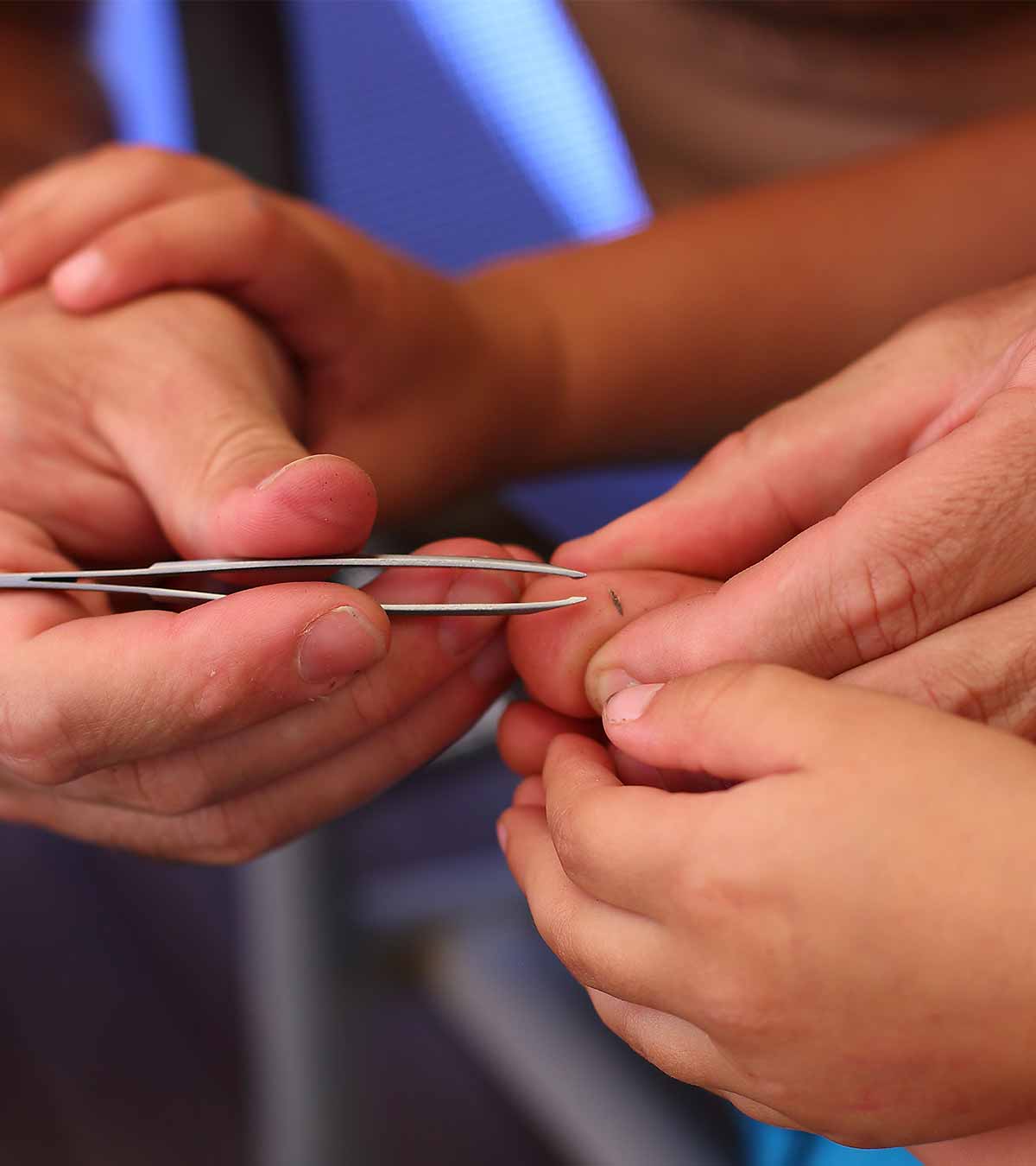
Image: iStock
A splinter is a tiny fragment of an object, such as plastic, wood, glass, or other material that penetrates the skin and stays embedded, causing pain. Since the pain can be bothersome for a child, you might be looking for ways to remove a splinter from a child’s skin. Although splinters aren’t a cause for immediate concern, leaving them in the skin may cause infections. Hence, removing splinters from the skin is vital to alleviate pain and mitigate the risk of other issues. So, keep reading to know how to remove a splinter and the aftercare it needs to minimize the risk of infection.
How To Remove A Splinter From A Child’s Skin?
Image: Shutterstock
There are various ways to remove a splinter from a child. Whichever way you choose, cleaning the area with water and soap is a must. Pat dry the skin using a clean towel. If the splinter is not deep and you can feel or see it in your child’s skin, the following methods can be tried.
1. Tweezer
It is the most common way to remove a splinter. Before using a tweezer or a needle, sterilize it by rubbing alcohol. You can also consider a disposable sterile needle available in a pharmacy. If the splinter is lodged at the tip and is visible, then you may gently pull it with a sanitized tweezer (1).
But if the tip is not visible, you may insert a needle close to the splinter to free it, and then use a tweezer to pull the splinter out. Additionally, you can use a magnifying glass to locate the splinter with ease. Once the splinter is removed, clean the affected part with alcohol.
The child should be explained the procedure beforehand so that they don’t move, to avoid any injury.
 Quick tip
Quick tip2. Tape
It works when the splinter is big or superficial. You may use duct tape or packing tape to cover the area that contains the splinter. Let the splinter stick to the tape and then gently pull the tape. It is a painless method of getting the splinter out from the child’s foot or finger or hand (2).
You may even use glue instead of tape. Once the glue is dried up, you may peel it away.
3. Baking soda
According to a report, soaking the affected area in a mixture of water and baking soda could help. Add a tablespoon of baking soda to a glass of water and soak the affected part twice a day. The splinter would come out by itself (3). This option may be useful if the splinter is on a finger, which can be easily dipped in a glass of water.
4. Drawing Salve method
According to anecdotal evidence, Drawing Salve could help remove splinters. Drawing Salve is an ointment made from a compound called ichthammol. You can purchase the ointment over-the-counter. Apply the ointment to the affected area and then cover it with a bandage. After a day, gently remove the bandage, and you can see the splinter (4).
5. Other ways
Some books suggest using essential oils (such as lavender and tea tree oil), Epsom salt, banana peel, potato slice, garlic, onion slice, aloe vera, coconut oil, and petroleum jelly to remove splinters (5) (6) (7) (8). A few others advise using hydrogen peroxide or saline solution to clean the affected area and remove the splinter from the skin. All these tricks are harmless and could be tried.
Care To Take After Removing The Splinter
Image: IStock
Once the splinter is removed, follow these tips:
- Wash the affected area with water and soap.
- Pat dry it, apply some antibiotic ointment such as mupirocin, fusidic acid or neomycin, and then cover the area with a bandage. You may also apply calamine lotion to soothe the affected area.
- If there is pain, you may rub ice on the affected area.
- If bleeding occurs while removing the splinter, then place cotton and apply a bandage on the affected part.
If the child is still troubled, then you should take them to the doctor.
When To See A Doctor?
Image: IStock
You need to see a doctor if the splinter does not come out after trying different methods. Also, see a doctor in the following circumstances.
- When the splinter is large or is stuck too deep within the skin.
- When the splinter breaks off, and a part is still inside.
- When the splinter gets into delicate parts (for instance, around the eye) of your child.
- When there are signs of infection such as redness, too much pain, warmth, swelling, blood or pus coming, and if the child gets a fever.
Based on the wound, your doctor may decide whether or not to give a tetanus shot.
 Point to consider
Point to considerWhat Happens If You Don’t Remove The Splinter?
Image: IStock
Splinters are not dangerous, and they usually come out with the methods tried at home. If not removed, it might result in:
- Pain and inflammation
- Increases the risk of infection
- Chills and fever as a result of bacterial infection
You or the child’s doctor is quite likely to remove the splinter before the occurrence of complications. Splinters are easy to avoid too.
 Point to consider
Point to considerHow To Prevent Splinters In Children?
Image: IStock
Take care to prevent a child from being hurt from a splinter while playing at home or outdoors.
- If there is carpentry work happening at home, then keep the child away from the place of work. After the job, clean the room so that there are no small wood fragments on the floor.
- Vacuum the floor thoroughly in case there is broken glass on it.
- Make the child wear shoes while playing outdoors.
- If the child plays with wooden toys, then make sure they are splinter-free and smooth.
- See to it that your child does not play near thorny plants or bushes.
- Rough surfaces such as porch railing, doors, windows, and wooden tables should be sand down at the corners.
Frequently Asked Questions
1. Does vinegar get splinters out?
Anecdotally, diluted vinegar is believed to be an effective way to bring the splinter to the top of the skin, but there is no scientific evidence. An easy way to remove the splinter would be to pull it out using sterilized tweezers.
2. How does Epsom salt remove splinters?
Epsom salt raises osmotic pressure on the skin. This pressure draws foreign objects, such as splinters, toward the surface. Dissolve a cup of Epsom salt in warm water and soak the affected skin in it for 10 minutes (9).
3. Will splinters come out on their own?
Tiny, superficial, and pain-free splinters come out on their own, along with the natural shedding of the skin, or the body will reject these splinters by forming a pimple that eventually drains out on its own (10).
Although not serious, splinters can be painful. If the splinter isn’t embedded deep into the skin and is visible, pulling it out with a tweezer and tape are a few ways to remove a splinter from the child’s skin. Once the splinter is removed, washing the affected area with soap and water, and applying antibiotic ointment is essential to avoid infection. Consulting a doctor is necessary if the splinter doesn’t come out even after trying different methods or the child exhibits signs of infection such as fever and too much pain at the affected site.
Infographic: Care To Take After Removing The Splinter
To prevent infection and promote healing, following proper aftercare for the skin is crucial once you remove the splinter. The following infographic provides guidelines for post-removal care. The steps can ensure that your child’s skin heals properly without causing major issues. Feel free to save and share the information with others. Illustration: Momjunction Design Team
Key Pointers
- A splinter is a fragment of an object that penetrates the skin and becomes embedded, and it may cause infections if left unattended.
- The splinter site should be cleaned before attempting to remove the splinter using tweezers, tape, baking soda, or essential oils.
- After removing the splinter, the affected area should be washed with soap and water, followed by application of antibiotic ointment, and a bandage to cover it.
- Medical attention should be sought if the splinter is not removed, causes infection, is large or deep, or breaks off during the extraction process.
- To prevent splinters in children, preventive measures such as wearing shoes, avoiding playing near thorny plants, and ensuring wooden toys are free of splinters should be practiced.
If your child is suffering from a splinter, it can be quite painful for them. Learn from this video which explains how to remove it and when to seek medical care.
References
1. Splinters; Stanford Children’s Health
2. Removing Splinters; British Columbia Healthlink
3. C. Hockin; Acid Blood Kills – Alkaline Blood Levels; academia.edu
4. G. Varozza; 501 Time-Saving Tips Every Woman Should Know
5. V. G. Fite and M. Gentles; Essential Oils for Healing: Over 400 All-Natural Recipes for Everyday Ailments
6. M. Sinclair; Modern Hydrotherapy for the Massage Therapist
7. R. J. Woodward; Generations of Family Favourites – Soup 2 Nuts
8. E. D. Morier; The Invention of Everything: Insights on Life, Food, and One Good Thermos
9. How To Remove a Splinter — and When to Call Your Doctor; Cleveland Clinic
10. Splinters and Other Foreign Bodies in the Skin; American Academy of Pediatrics





